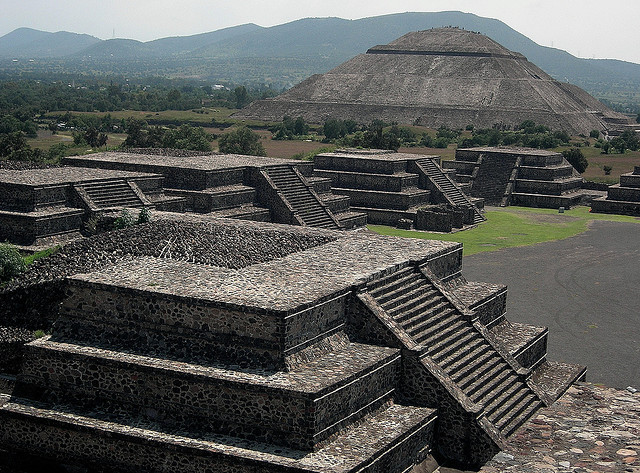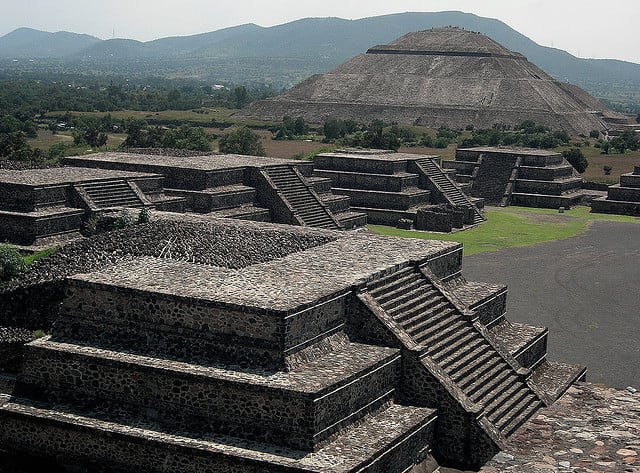
Support justice-driven, accurate and transparent news — make a quick donation to Truthout today!
 The early history of Teotihuacán is quite mysterious, and the origin of its founders is debated. For many years, archaeologists believed it was built by the Toltec people, an early Mexican civilization. The earliest buildings at Teotihuacán date to about 200 BCE, and the largest pyramid, the Pyramid of the Sun, was completed by 100 CE. (Photo: Teseum)
The early history of Teotihuacán is quite mysterious, and the origin of its founders is debated. For many years, archaeologists believed it was built by the Toltec people, an early Mexican civilization. The earliest buildings at Teotihuacán date to about 200 BCE, and the largest pyramid, the Pyramid of the Sun, was completed by 100 CE. (Photo: Teseum)
If a secret can keep for two millennia, another decade probably won’t hurt — but it’s pretty amazing when you consider the fact that said secret was buried under one of Mexico’s most popular tourist sites. The city of Teotihuacan, mysteriously abandoned some 2,000 years ago, is home to an amazing array of ancient, but largely unfathomable, structures. It’s recognized as a UNESCO World Heritage Site, in a nod to its archaeological, cultural and historical importance.
The fascinating site, located just outside Mexico City, is a famous destination thanks to how easily it can be reached, and it’s often found crawling with tourists, which is why archaeologists were amazed when it yielded a new secret in 2003: A tunnel leading deep beneath the city that was filed with a treasure-trove of artifacts.
It took them eleven years to excavate, during which they remained silent to ensure that the integrity of the site wasn’t compromised, and the tunnel still needs further excavations to explore it more fully. What researchers found was incredible: A huge assortment of religious offerings, the remains of jaguars, and what may be human remains as well — although no gravesites were discovered. The offerings were all found below the famous Temple of the Plumed Serpent, and may be linked to the city’s system of priests and rulers, which would make them a very important archaeological and historical finding. It’s possible that deeper excavation may reveal grave sites and tombs of the city’s most powerful and elite.
Sergio Gómez, the lead archaeologist on the project, is from Mexico, and he along with the rest of his team started out with robots before moving into the tunnel, carefully removing material layer by layer and sifting it to ensure that they didn’t miss a single piece of important evidence about the site’s past. Nearly 50,000 artifacts were uncovered, making the investigation of the site no simple task. The finds included jade carvings, a number of wooden artifacts and objects like rubber balls — it turns out that Mesoamericans liked playing ball too.
The find comes in the midst of a larger global push to repatriate objects looted from Mesoamerica from the conquest of the Americas until very recently. A growing number of museums have found themselves under pressure to return objects to their native context, rather than retaining them in their own collections, and have been encouraged to display replicas instead to allow visitors to experience Mesoamerican culture.
Meanwhile, private collectors still trade such artifacts on the black market, in flagrant violation of international law. For Mexico, being able to excavate a site with regionally-based archaeologists and researchers marks a radical departure from being forced to sit by while outsiders strip a site of artifacts, which was the practice in the past.
The value of such artifacts comes in curious contrast to attitudes about Mesoamerican history and culture from some Westerners. Despite the fact that the region’s history dates back over millennia, with considerable evidence at finds like these of advanced, complex cultures to rival those of the West, some continue to insist that European history in particular is older (and, it’s implied, superior) to that of the Mesoamericas.
These attitudes ignore the rich history of the region, and carry colonial overtones, reflecting the same attitudes brought to the region in the age of exploration, when Spanish conquistadors and other Westerners arrived and justified their claims upon the Americas in part on the grounds that the indigenous inhabitants were “savages.” Yet, a culture that creates precious and beautiful artifacts doesn’t seem terribly savage — and that culture rose and fell long before Columbus set sail.
Press freedom is under attack
As Trump cracks down on political speech, independent media is increasingly necessary.
Truthout produces reporting you won’t see in the mainstream: journalism from the frontlines of global conflict, interviews with grassroots movement leaders, high-quality legal analysis and more.
Our work is possible thanks to reader support. Help Truthout catalyze change and social justice — make a tax-deductible monthly or one-time donation today.